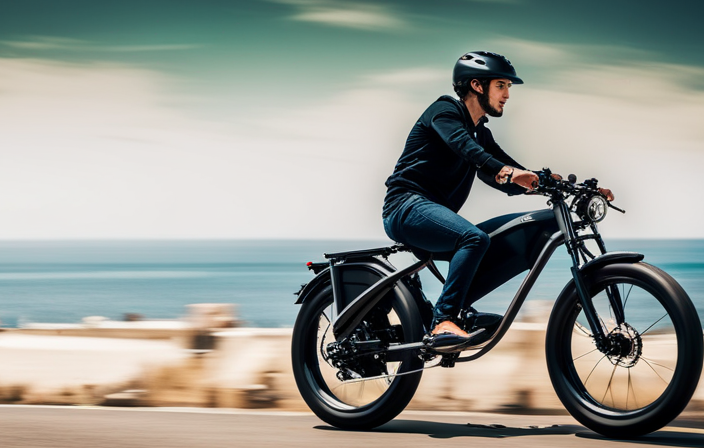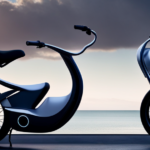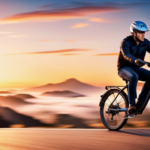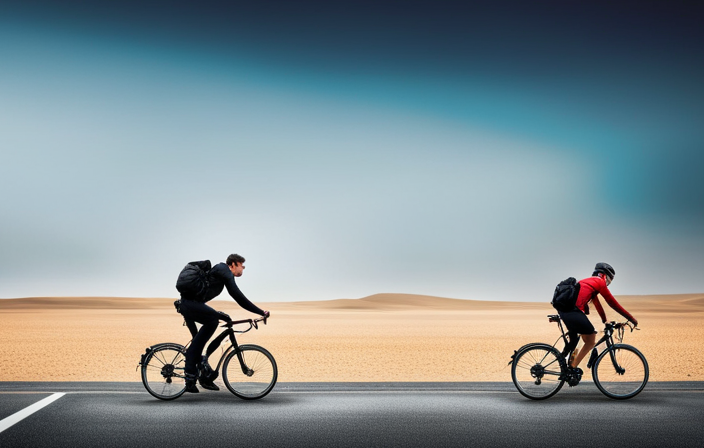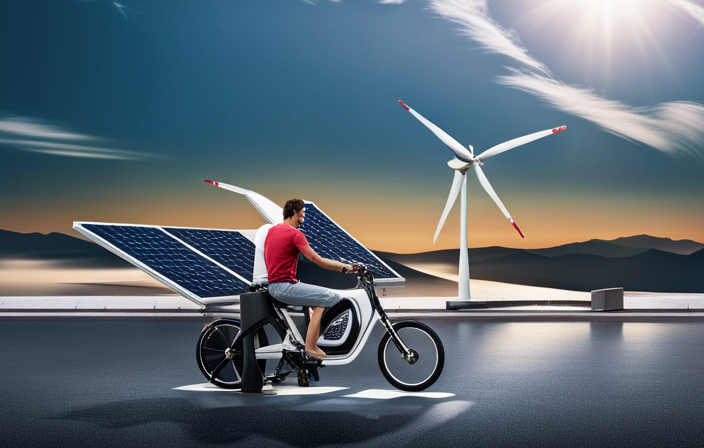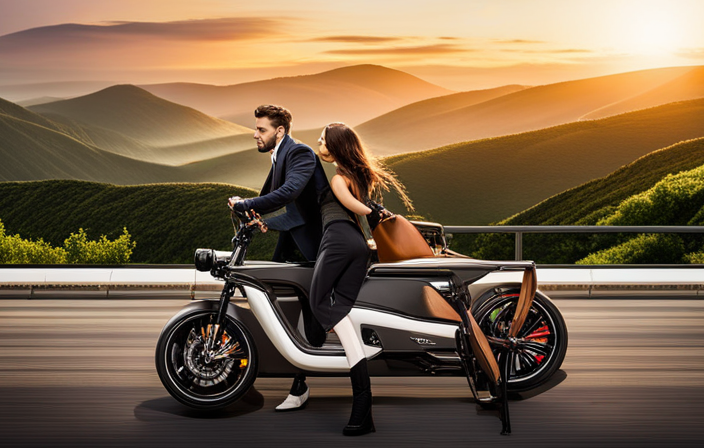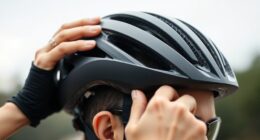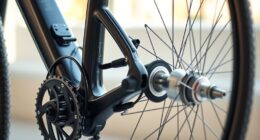Did you know that a 500W electric bike can reach speeds of up to 28 miles per hour? That’s faster than most people can pedal on a traditional bicycle!
In this article, we will explore the factors that affect the speed of electric bikes, the legal limitations and regulations surrounding their maximum speeds, as well as tips for safely riding at high speeds.
Whether you’re a speed enthusiast or simply curious about electric bike capabilities, this article will provide you with all the technical details you need to know.
Key Takeaways
- Rider weight affects the acceleration and top speed of a 500W electric bike.
- Battery life and capacity play a significant role in determining the speed of the electric bike.
- The efficiency of the motor and its design can enhance the speed of the electric bike.
- Pedal assist can provide additional power and optimize speed by maximizing power transfer and maintaining a steady cadence.
Understanding Electric Bike Power Ratings
So, you’re probably wondering how fast you can go on a 500w electric bike, huh? Well, let’s dive into the first subtopic: understanding electric bike power ratings.
The motor power of an electric bike is measured in watts, and a 500w motor is quite powerful. This means it can provide a significant amount of torque, allowing you to accelerate quickly and tackle steep hills with ease. However, it’s important to note that motor power alone doesn’t determine the top speed of an electric bike. The speed control system also plays a crucial role.
Some electric bikes with a 500w motor can reach speeds of up to 20 mph, while others may have speed limiters that cap the speed at a lower level for safety reasons.
Now, let’s move on to the basics of electric bike speed.
The Basics of Electric Bike Speed
Imagine yourself riding an electric bike powered by a 500-watt motor, effortlessly gliding through the streets like a gentle breeze moving through a field of wildflowers. When it comes to electric bike speed, acceleration plays a crucial role. With a 500-watt motor, the bike can reach higher speeds faster than those with lower wattage motors. To better understand the relationship between electric bike power and speed, let’s take a look at the following table:
| Power (Watts) | Speed (mph) |
|---|---|
| 250 | 15 |
| 500 | 20 |
| 750 | 25 |
| 1000 | 28 |
As you can see, increasing the power output results in higher speeds. However, it’s important to note that these speeds can vary depending on factors such as rider weight, terrain, and wind resistance. Furthermore, it’s worth mentioning that speedometers on electric bikes may not always be perfectly accurate. In the next section, we will explore the various factors that can affect electric bike speed, providing a comprehensive understanding of this exciting mode of transportation.
Factors That Affect Electric Bike Speed
One of the key factors that impact the speed of an e-bike is the power output of its motor. The motor power, measured in watts (W), determines how much force the motor can generate to propel the bike forward. Understanding motor power is crucial in determining the maximum speed an e-bike can achieve.
When it comes to the impact of terrain on electric bike speed, several factors come into play. Uphill gradients, for example, can significantly affect the speed at which an e-bike can travel. Steeper inclines require more power from the motor to maintain a certain speed. Additionally, factors such as wind resistance, tire pressure, and rider weight can also influence the overall speed of the bike.
Considering these various factors, it is important to understand how they can affect the maximum speeds of 500W electric bikes.
Maximum Speeds of 500W Electric Bikes
With a motor power output of 500W, these e-bikes can reach speeds that will make your heart race. The maximum speeds of 500W electric bikes can vary depending on various factors such as terrain, rider weight, and wind resistance. On flat surfaces, these e-bikes can typically reach speeds between 20 to 28 mph (32 to 45 km/h). However, when faced with uphill climbs or unfavorable conditions, the speed may decrease to around 12 to 15 mph (19 to 24 km/h). It’s important to note that these speed variations are approximate and can be influenced by individual bike specifications and performance. Now, let’s delve into the legal limitations and regulations regarding the use of these high-speed electric bikes.
Legal Limitations and Regulations
Now, let’s explore the legal restrictions and rules that govern the use of these high-powered e-bikes.
When it comes to 500W electric bikes, there are specific legal requirements that riders must adhere to. In many countries, including the United States, there is a speed limit enforcement in place for electric bikes. The maximum speed allowed on these bikes is typically 20 mph (32 km/h). This speed limit is implemented to ensure the safety of riders and other road users. It is important for riders to be aware of and obey these regulations to avoid any legal consequences.
Moving forward to the next section discussing the top speeds achievable on flat terrain, it is essential to understand the legal limitations first.
Top Speeds Achievable on Flat Terrain
When cruising on a level surface, riders can reach impressive speeds with these high-powered e-bikes. With a 500W electric bike, the top speed achievable on flat terrain can vary depending on several factors, including the weight of the rider and the bike, road conditions, and the level of assistance provided by the motor.
Here are three key factors that can impact the top speed:
-
Upgrading components: Upgrading the bike’s components, such as the tires, drivetrain, or aerodynamic accessories, can help reduce friction and improve efficiency, allowing the bike to reach higher speeds.
-
Impact of wind speed: Wind resistance plays a significant role in determining the top speed of an electric bike. Riding against a strong headwind can significantly reduce the bike’s speed, while riding with a tailwind can increase it.
-
Motor power and assistance level: The power output of the motor and the level of assistance it provides can also affect the top speed. A higher-powered motor and increased assistance level can result in higher speeds.
As we explore uphill speeds and power consumption, it is important to consider how these factors influence the overall performance of the bike.
Uphill Speeds and Power Consumption
After discussing the top speeds achievable on flat terrain, let’s now delve into the uphill speeds and power consumption of a 500W electric bike.
Uphill acceleration is a crucial factor to consider when evaluating the performance of an electric bike. With a 500W motor, the uphill speed of the bike may vary depending on the weight of the rider and the gradient of the slope. Generally, the higher the wattage, the better the uphill acceleration.
However, it’s important to note that the power consumption will also increase when tackling inclines, which can impact the battery range. To ensure a satisfactory uphill speed and conserve battery life, it is advisable to choose an electric bike with a higher wattage motor and consider optimizing your riding technique.
Now, let’s shift our focus to the subsequent section about downhill speeds and safety considerations.
Downhill Speeds and Safety Considerations
Descending a slope on a 500W e-bike requires careful control and consideration for safety. To ensure a safe descent, proper downhill braking techniques must be employed. This includes utilizing both the front and rear brakes simultaneously to evenly distribute the braking force and prevent wheel lock-up. It is also crucial to maintain a low center of gravity by shifting my weight towards the rear of the bike to enhance stability.
Additionally, minimizing wind resistance is essential in achieving higher speeds while descending. By adopting an aerodynamic posture and tucking in my elbows and knees, I can reduce drag and maximize my downhill speed. This allows me to harness the full potential of the 500W motor and experience exhilarating downhill rides.
In the subsequent section about speed variations based on rider weight, we will explore how different weights can impact the overall performance and speed of a 500W electric bike.
Speed Variations Based on Rider Weight
The weight of the rider significantly impacts the overall performance and speed of a 500W e-bike. When testing the speed of an electric bike, it is important to consider the weight of the rider as it directly affects the acceleration and top speed capabilities. Heavier riders may experience slightly slower speeds compared to lighter riders due to the additional load on the motor.
Speed testing methods involve measuring the time it takes the bike to reach a certain speed or the distance covered in a specific time frame. By conducting these tests with riders of varying weights, we can observe the impact of rider weight on the speed of a 500W e-bike.
Transitioning into the next section, the speed variations based on battery life can also greatly influence the overall performance of the bike.
Speed Variations Based on Battery Life
When it comes to determining the speed of a 500W electric bike, rider weight is not the only factor to consider. Another crucial variable is the battery life and capacity.
The battery is the powerhouse of an electric bike, supplying the necessary energy to drive the motor. As the battery depletes, its ability to deliver power to the motor diminishes, resulting in a decrease in speed.
Additionally, the terrain on which the bike is being ridden also influences its speed. Uphill climbs require more power and can cause a reduction in speed, while flat surfaces allow for greater speeds.
Finally, the battery’s capacity and the impact of different terrains must be taken into account when determining the maximum speed of a 500W electric bike. Understanding these variables is essential in comprehending the role of motor efficiency in achieving optimal speeds.
The Role of Motor Efficiency
To fully appreciate your ride, consider how efficiently the motor operates in achieving optimal speeds. The motor power of a 500W electric bike plays a crucial role in determining its top speed. A higher power motor can generate more torque, allowing the bike to reach higher speeds. However, motor efficiency is equally important. A well-designed and efficient motor can convert a larger percentage of the electrical energy into mechanical power, resulting in better speed performance.
Additionally, the aerodynamic design of the bike also contributes to its overall speed. A sleek and streamlined frame reduces air resistance, enabling the bike to glide through the wind more effortlessly.
By maximizing motor power and optimizing aerodynamic design, you can enhance the speed capabilities of your electric bike.
Transitioning into the subsequent section about enhancing speed with pedal assist, let’s explore another way to boost your ride.
Enhancing Speed with Pedal Assist
By utilizing pedal assist, riders can turbocharge their e-bike experience and feel like they’re effortlessly cruising on a cloud. Pedal assist, also known as electric bike (e-bike) power assist, is a feature that enhances speed by providing additional power to the rider’s pedal strokes. This system works by sensing the rider’s pedaling effort and automatically activating the motor to provide a boost. The efficiency of this pedal assist greatly impacts the overall speed and performance of the e-bike. To optimize pedal efficiency, riders can employ various training techniques, such as maintaining a steady cadence and utilizing proper gear ratios. These techniques help to maximize power transfer and minimize energy wastage. Incorporating these strategies allows riders to reach higher speeds and cover longer distances while conserving battery life. With pedal assist, e-bike riders can experience an exhilarating ride that effortlessly propels them forward. Transitioning into the subsequent section about important safety tips for high-speed riding, it is vital to ensure a secure and enjoyable e-bike experience.
Important Safety Tips for High-Speed Riding
Riding at high speeds on an e-bike requires a keen awareness of one’s surroundings and a firm grip on the handlebars. To ensure safety while riding at high speeds, it is crucial to undergo speed training and wear appropriate protective gear.
Speed training helps in improving your reaction time and maneuvering skills, allowing you to navigate through traffic and unexpected obstacles with ease. Additionally, wearing protective gear such as a helmet, knee pads, and elbow pads is essential to minimize the risk of injury in case of a fall or accident. These safety measures are crucial for high-speed riding and should never be overlooked.
Now, let’s explore the speeds of different electric bike models and compare their performance.
Comparing Speeds of Different Electric Bike Models
Zooming down the road on an e-bike is like gliding on a gentle breeze, with different models offering varying levels of exhilarating speed. When it comes to electric bike acceleration, the power of the motor plays a crucial role.
A 500W electric bike can reach speeds of up to 20 miles per hour (32 kilometers per hour), allowing for quick and efficient travel. However, it’s important to note that the top speed may vary depending on factors such as the weight of the rider, terrain, and battery efficiency.
Comparing speeds between different electric bike models is essential to find the one that suits your needs. Some models may offer higher speeds, while others prioritize other features such as range or comfort. Finding the right electric bike for your speed requirements will ensure an enjoyable and safe riding experience.
Choosing the Right Electric Bike for Your Speed Needs
When it comes to finding the perfect e-bike for your need for speed, it’s crucial to choose the right model that matches your desired level of exhilaration. Electric bikes offer several advantages over traditional bikes, especially when it comes to speed.
Here are some key factors to consider when choosing the right electric bike for your speed needs:
-
Motor Power: Look for a model with a higher wattage motor, such as a 500W motor, which can provide more power and speed compared to lower wattage options.
-
Battery Capacity: A larger battery capacity will allow for longer rides at higher speeds, ensuring that you can maintain your desired speed for a longer period of time.
-
Pedal Assist Levels: Different electric bikes offer varying levels of pedal assist, allowing you to choose the level of assistance you need to reach your desired speed.
-
Weight and Frame Design: Lighter weight and aerodynamic frame designs can contribute to increased speed and efficiency.
Electric bikes offer numerous benefits over traditional bikes, including the ability to reach higher speeds with less effort, making them a great choice for those looking for a thrilling and efficient ride.
Frequently Asked Questions
How does the speed of a 500W electric bike compare to that of a regular bike?
The speed of a 500w electric bike is simply mind-blowing when compared to a regular bike. With its powerful motor and efficient design, the electric bike leaves its counterpart in the dust.
Can the speed of a 500W electric bike be adjusted or limited?
Yes, the speed of a 500W electric bike can be adjusted or limited through speed adjustment settings or power limitation mechanisms. These features allow the rider to control and modify the maximum speed output of the bike.
Are there any additional factors that can affect the top speed of a 500W electric bike?
There are several additional factors that can affect the top speed of a 500w electric bike. Factors such as wind resistance, terrain, rider weight, and tire pressure can all contribute to either increasing or decreasing the bike’s maximum speed.
What are the safety considerations when riding a 500W electric bike at maximum speeds?
When riding a 500w electric bike at maximum speeds, it is crucial to prioritize safety. Wearing appropriate safety equipment such as helmets and knee pads is essential. Additionally, mastering proper handling techniques, including maintaining balance and using the brakes effectively, is vital.
Are there any restrictions or regulations regarding the use of 500W electric bikes on public roads?
There are regulations and speed limits that apply to the use of 500w electric bikes on public roads. It is important to comply with these regulations to ensure safety and legal compliance.
Conclusion
To conclude, after analyzing the power ratings and speed capabilities of 500W electric bikes, it is evident that they offer impressive speed potential. However, it is crucial to consider various factors like terrain, weight, and battery life, as these can impact the maximum speed achievable.
It is also important to adhere to legal limitations and regulations while riding. By selecting the right electric bike and utilizing pedal assist, riders can enhance their speed experience.
Remember, ‘the sky’s the limit’ when it comes to the exhilarating speed of electric bikes.
